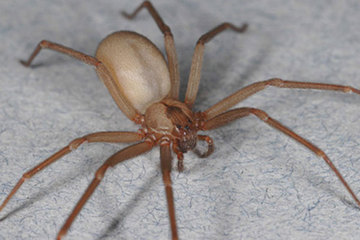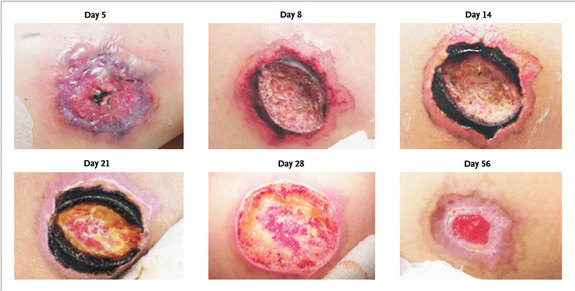The brown recluse spider is known for its violin-shaped marking along its back, but the marking can sometimes be hard to see because it is only about 3/8 of an inch in length and 3/16 of an inch in width. Males are typically smaller than the females but with longer legs. Within the United States, the brown recluse spider lives in the southern and central states. They typically live in piles of wood, logs, leaves or rocks, but can live in human’s home as well. Although not aggressive, you may be bitten by brown recluse spider if the insect feels threatened.

What Are the Symptoms of Brown Recluse Spider Bite?
In most cases, a brown recluse spider bite is painless. In other cases, you will notice a minor burning feeling at first, followed by a small white blister. Symptoms will usually start developing about two or eight hours following a bite. You may notice muscle pain, fever, vomiting, nausea, severe itching or severe pain at the site of the bite around four hours after being bitten.
The bite site starts off slightly red and typically heals with minimal scarring within days or weeks. In some cases, there is a severe reaction with blistering and erythema or blue discoloration, scarring or a necrotic lesion. Blistering is common while the death of the subcutaneous fat and skin is less common and severe necrotic lesions are rare.

Can Brown Recluse Spider Bite Be Fatal?
It is not fatal. There has never been a verified death in the US due to a brown recluse spider bite. It can, in rare cases, cause tissue damage. Experts suggest that anecdotes of death from these bites are due to bacterial infections or other causes. You should still visit your doctor when bitten by this spider.
What to Do If a Brown Recluse Spider Bites Me?
The first thing to do is staying calm. If you move too much or get too anxious, the venom flows faster throughout your blood. You should then apply a wet, cool cloth to your bite or cover it by a cloth then place an ice bag on the top. Don’t apply a tourniquet as it may cause damage. It’s best if you can find the spider that bites you and verify that it is a brown recluse. Be ready to call your doctor if an open sore and/or black, dead tissue develop or if you have severe symptoms affecting your entire body.
Medical Treatment for Brown Recluse Spider Bite
- Doctors do not follow a set course of treatment for these bites. You won’t find an effective anti-venom like for other spider species.
- In some cases, the wound by the site of the bite will develop a bacterial infection. In this case, you will get antibiotics. You may also be prescribed steroids to minimize inflammation or antihistamines to help with the itching.
- In some cases, your doctor may give you a brace or sling to elevate the limb that was bitten in a comfortable manner.
Tips for Preventing Brown Recluse Spider Bite
1. Inspect the exterior of your house for small holes or openings, particularly close to the entry point of utility pipes. Use silicone caulk to seal these entry points.
2. Make sure firewood is stacked a minimum of twenty feet away from your home with the wood five inches off the ground as this deters spiders from hiding there. Always wear gloves when handling the wood and check it for spiders before bringing it inside.
3. Store shoes and clothes within plastic containers. Shake out clothing in hampers, in storage, or on your floor before wearing them. Remember to be cautious when putting on clothing that isn’t frequently used, like gloves, skates or baseball mitts.
4. Routinely clean your home thoroughly. Reduce clutter in your basement, attic and garage. Install door sweeps and window screens that fit tightly. Clean the area behind any exterior shutters.
5. You can install sodium vapor or yellow light bulbs by entrances since these are less attractive for spiders and other insects.
